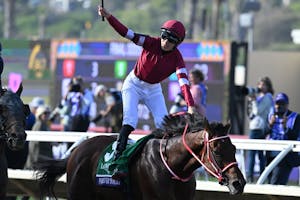Analyzing Workouts

TwinSpires logo
One of the toughest things for handicappers to assess is workouts — or so the experts tell us.
“It’s not how fast they work, it’s how they work fast,” the clockers say.
Well, call me stubborn, but when I see a horse work six furlongs in 1:11, as Runhappy did recently in preparation for the Grade I King’s Bishop at Saratoga on Aug. 29, I don’t need to have seen the work to know it was impressive.

In fact, Runhappy’s sizzling move prompted me to fire up my computer and see if there was a way to gauge workouts without relying on the subjective opinions of clockers.
So, utilizing my largest (testing) database, which has statistics on more than 14,300 races, I first generated the numbers on horses that worked out since their last race, within the past 10 days, to serve as a measuring stick:
Number: 28,382
Winners: 3,967
Win Rate: 14.0%
$2 Net (ROI): $1.56 (-22.12%)
IV: 1.13
OBIV: 0.84
Next, from the 28,382 horses above, I looked for those that recorded the best time at the track and distance in their latest workout:
Number: 4,436
Winners: 675
Win Rate: 15.2%
$2 Net (ROI): $1.56 (-21.99%)
IV: 1.20
OBIV: 0.86
Nothing to write home about… but look what happens when I insist that at least 14 other horses recorded a work at the track and distance in question:
Number: 993
Winners: 198
Win Rate: 19.9%
$2 Net (ROI): $1.89 (-5.26%)
IV: 1.57
OBIV: 0.99
Not only do these horses win more than random chance would dictate (1.57 impact value), they also outrun their odds (0.99 odds-based impact value). If we further insist that the last workout be contested at four furlongs or greater, we add to the good vibrations.
The potency of this straightforward approach to workouts was demonstrated on consecutive days at Saratoga, Arlington Park and Hastings Racecourse earlier this month.

After a nice comeback run in the Grade III Dwyer on July 4, Breeders’ Cup Juvenile Champ Texas Red topped 47 others with a :59-3/5 five-furlong work at Saratoga on July 25, signaling his readiness in the Grade II Jim Dandy a week later.

The next day, a five-year-old gelding named Valiant City made his third start of the year in a $62,500 optional claiming affair at Arlington Park following a best-of-19 five-furlong drill on July 30.

Just like Texas Red, Valiant City made short work of his five rivals.

Showing that this kind of exercise analysis need not be confined to the bigger ovals, I’m Big Trouble bested 26 other workers with a 1:00-4/5 five-furlong blowout on July 26 at Hastings Racecourse.

Eight days later he got up to win a starter stakes at 1-3/8 miles, returning $12.90 to his backers.

Now, lest I face any undue criticism: I am not saying that this is the only way to evaluate workouts. I am simply presenting a stats-backed method that players might find helpful and, hopefully, with a little tinkering, profitable.

ADVERTISEMENT


